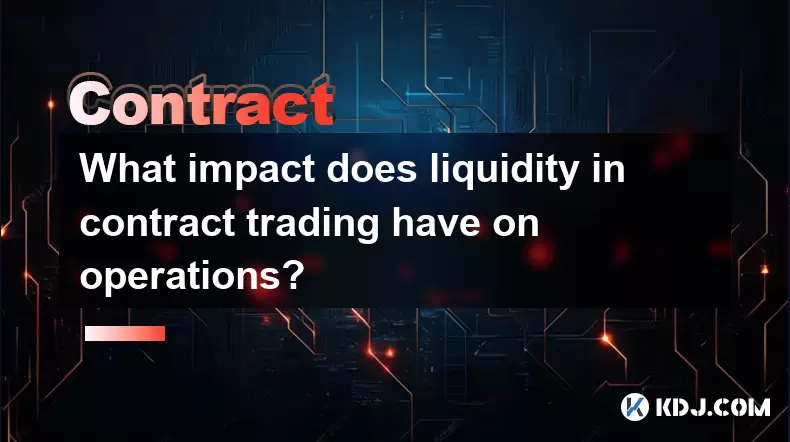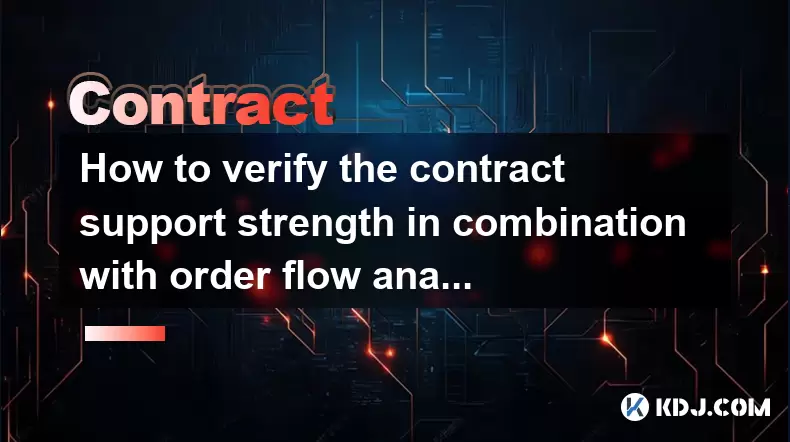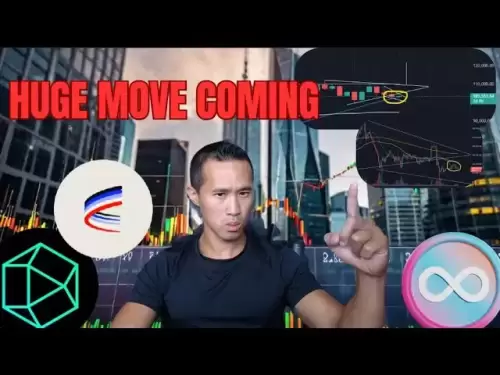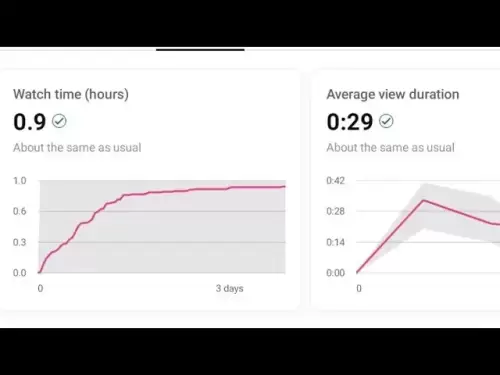-
 Bitcoin
Bitcoin $103,456.1111
0.49% -
 Ethereum
Ethereum $2,414.9631
0.02% -
 Tether USDt
Tether USDt $1.0006
0.05% -
 XRP
XRP $2.1083
0.24% -
 BNB
BNB $634.8760
-0.76% -
 Solana
Solana $139.8437
1.94% -
 USDC
USDC $0.9998
-0.01% -
 TRON
TRON $0.2737
0.97% -
 Dogecoin
Dogecoin $0.1602
0.20% -
 Cardano
Cardano $0.5737
1.08% -
 Hyperliquid
Hyperliquid $32.9779
-2.54% -
 Bitcoin Cash
Bitcoin Cash $474.8886
-1.80% -
 Sui
Sui $2.6272
-1.99% -
 Chainlink
Chainlink $12.4878
0.14% -
 UNUS SED LEO
UNUS SED LEO $8.9234
0.35% -
 Stellar
Stellar $0.2411
-0.18% -
 Avalanche
Avalanche $17.0274
-0.70% -
 Toncoin
Toncoin $2.8936
-1.11% -
 Shiba Inu
Shiba Inu $0.0...01112
-0.58% -
 Litecoin
Litecoin $82.6982
1.33% -
 Hedera
Hedera $0.1423
-0.05% -
 Monero
Monero $314.8455
3.26% -
 Ethena USDe
Ethena USDe $1.0006
0.01% -
 Polkadot
Polkadot $3.4043
1.14% -
 Dai
Dai $0.9999
0.01% -
 Bitget Token
Bitget Token $4.2848
-0.13% -
 Uniswap
Uniswap $6.8748
-5.45% -
 Pepe
Pepe $0.0...09661
0.52% -
 Pi
Pi $0.5359
1.19% -
 Aave
Aave $242.9168
-1.03%
What impact does liquidity in contract trading have on operations?
High liquidity in contract trading ensures quick order execution at stable prices, reducing slippage and improving trade efficiency, especially in volatile crypto derivatives markets.
Jun 22, 2025 at 04:35 am

Understanding Liquidity in Contract Trading
Liquidity in contract trading refers to the ease with which a trader can buy or sell a contract without causing significant price movements. High liquidity ensures that orders are executed quickly at stable prices, while low liquidity may result in slippage and unpredictable trade outcomes. In cryptocurrency derivatives markets, where volatility is common, understanding how liquidity impacts operations becomes crucial for traders aiming for consistency and control.
Importance of Bid-Ask Spread in High-Liquidity Markets
One of the most immediate effects of liquidity on contract trading is reflected in the bid-ask spread. A narrow bid-ask spread indicates high liquidity, allowing traders to enter and exit positions with minimal cost. Conversely, a wide spread often signals thin order books and fewer participants willing to take the opposite side of a trade. This can lead to increased transaction costs and less favorable entry points, especially when placing large orders.
For instance, during periods of high market activity—such as major news releases or macroeconomic announcements—the bid-ask spread may widen temporarily due to sudden changes in demand and supply. Traders should monitor these spreads closely before executing trades, particularly when using limit orders.
Slippage and Its Relevance to Trade Execution
Slippage occurs when a trade is executed at a different price than expected, typically due to low liquidity or rapid price movements. In illiquid markets, slippage can significantly affect profitability, especially when trading large volumes or during volatile market conditions. For example, if a trader places a market order for a futures contract in a thinly traded pair, they may end up paying a much higher price than anticipated because there aren’t enough orders to absorb the volume.
To mitigate this, traders can use tools like price depth charts to assess the available liquidity at various price levels. Additionally, setting slippage tolerances within trading platforms can prevent unintended execution prices, although it may also result in partial fills or missed opportunities.
Order Book Depth and Market Impact
Order book depth plays a pivotal role in determining how much impact a trade will have on the market. A deep order book means that large orders can be absorbed without causing drastic price shifts. Traders analyzing order book depth can gauge whether entering or exiting a position will disturb the current price equilibrium. On the other hand, shallow order books amplify the risk of market manipulation and erratic price swings.
For traders engaging in arbitrage or scalping strategies, monitoring real-time order book data is essential. Platforms offering order book visualization tools allow users to see cumulative bid and ask sizes at different price levels. By studying this data, traders can plan their entries and exits more strategically, avoiding unnecessary disruptions to the market.
Funding Rates and Their Relationship with Perpetual Contract Liquidity
In perpetual futures contracts, funding rates are mechanisms used to tether the contract price to the spot price of the underlying asset. The liquidity of a perpetual contract can influence how smoothly funding rate adjustments occur. In highly liquid markets, funding payments tend to be smaller and more predictable, as there's ample participation from both long and short positions.
However, in less liquid perpetual contracts, funding rates might fluctuate more dramatically, leading to increased holding costs for open positions. This is particularly relevant for swing traders or investors who hold positions over extended periods. Monitoring funding rate history and predicted future rates can help traders manage their exposure and avoid unexpected expenses.
Risk Management Considerations in Low-Liquidity Scenarios
Operating in environments with limited liquidity introduces unique risks that traders must account for in their risk management strategies. Stop-loss orders may not trigger as intended in low-liquidity conditions, leaving traders exposed to larger losses than planned. Similarly, profit targets may remain unmet due to insufficient buyers or sellers at desired price points.
To address these concerns, traders can implement alternative techniques such as trailing stops or conditional orders that adjust dynamically based on market conditions. It’s also advisable to diversify across multiple exchanges or trading pairs to ensure access to sufficient liquidity when needed. Setting daily volume thresholds before initiating trades can further safeguard against poor execution quality.
Frequently Asked Questions (FAQs)
How does liquidity differ between spot and futures markets?
Liquidity in spot markets typically reflects real-time buying and selling interest for an actual asset, whereas in futures markets, it represents the willingness of traders to take positions on future price movements. Futures contracts, especially perpetual ones, often exhibit different liquidity profiles depending on market sentiment, funding dynamics, and exchange-specific factors.
Can I check liquidity before placing a trade?
Yes, most advanced trading platforms provide tools such as depth charts, order book analyzers, and volume indicators that allow traders to assess liquidity before executing trades. These tools show the amount of buy and sell orders at various price levels, helping traders estimate potential slippage and execution quality.
What are some signs of deteriorating liquidity?
Signs of declining liquidity include widening bid-ask spreads, frequent slippage on standard market orders, and difficulty in filling large orders at desired prices. Additionally, sharp price spikes followed by quick reversals often indicate thin markets where a few trades can disproportionately affect pricing.
How do exchanges influence liquidity in contract trading?
Exchanges play a critical role in shaping liquidity through maker-taker fee models, incentive programs for market makers, and listing decisions. Exchanges with higher trading volumes and robust infrastructure generally offer better liquidity. Some platforms also partner with institutional liquidity providers to enhance order book depth and improve execution for retail traders.
Disclaimer:info@kdj.com
The information provided is not trading advice. kdj.com does not assume any responsibility for any investments made based on the information provided in this article. Cryptocurrencies are highly volatile and it is highly recommended that you invest with caution after thorough research!
If you believe that the content used on this website infringes your copyright, please contact us immediately (info@kdj.com) and we will delete it promptly.
- Ruvi AI: The Audited Token Poised to Outshine Shiba Inu
- 2025-06-22 10:25:12
- Dypians, DeFi, and Sei Network: A Deep Dive into the Latest Trends
- 2025-06-22 10:25:12
- Bitcoin, Corporate Treasuries, and Investment: A New Era?
- 2025-06-22 10:45:12
- Bitcoin Price, Realized Price & CryptoQuant: What's Driving the Bull Run?
- 2025-06-22 10:45:12
- Ruvi AI: The Audited Token Eclipsing Shiba Inu's Meme Coin Mania?
- 2025-06-22 11:05:12
- Bitcoin, CBD, and Heatmaps: Decoding the Crypto Tea Leaves, NY Style
- 2025-06-22 11:25:12
Related knowledge

How to use the price slope to filter the false breakthrough signal of the contract?
Jun 20,2025 at 06:56pm
Understanding the Concept of Price Slope in Contract TradingIn contract trading, especially within cryptocurrency derivatives markets, price slope refers to the rate at which the price changes over a specific time period. It helps traders assess the strength and sustainability of a trend. A steep slope may indicate strong momentum, while a shallow slope...

How to determine the expected volatility of the contract through the volatility cone?
Jun 19,2025 at 12:28pm
Understanding the Basics of Volatility in Cryptocurrency ContractsIn the realm of cryptocurrency trading, volatility is a key metric that traders use to assess potential risk and reward. When dealing with futures contracts, understanding how volatile an asset might become over time is crucial for position sizing, risk management, and strategy developmen...

How to formulate a contract intraday trading plan in combination with the pivot point system?
Jun 21,2025 at 03:42pm
Understanding the Basics of Pivot Points in Cryptocurrency TradingPivot points are technical analysis tools used by traders to identify potential support and resistance levels. These levels are calculated using the previous day's high, low, and closing prices. In the context of cryptocurrency trading, where markets operate 24/7, pivot points help trader...

How to use the volume swing indicator to predict the contract volume-price divergence?
Jun 18,2025 at 11:42pm
Understanding the Volume Swing IndicatorThe volume swing indicator is a technical analysis tool used primarily in cryptocurrency trading to evaluate changes in volume over time. Unlike price-based indicators, this metric focuses solely on trading volume, which can provide early signals about potential market reversals or continuations. The key idea behi...

How to use the Gaussian channel to set the contract trend tracking stop loss?
Jun 18,2025 at 09:21pm
Understanding the Gaussian Channel in Cryptocurrency TradingThe Gaussian channel is a technical indicator used primarily in financial markets, including cryptocurrency trading, to identify trends and potential reversal points. It is based on statistical principles derived from the normal distribution, commonly known as the Gaussian distribution or bell ...

How to verify the contract support strength in combination with order flow analysis?
Jun 20,2025 at 12:28pm
Understanding Contract Support Strength in CryptocurrencyIn the realm of cryptocurrency trading, contract support strength refers to the resilience of a price level where buying interest is expected to overcome selling pressure. This concept becomes even more nuanced when analyzed alongside order flow, which provides insights into the dynamics of buy an...

How to use the price slope to filter the false breakthrough signal of the contract?
Jun 20,2025 at 06:56pm
Understanding the Concept of Price Slope in Contract TradingIn contract trading, especially within cryptocurrency derivatives markets, price slope refers to the rate at which the price changes over a specific time period. It helps traders assess the strength and sustainability of a trend. A steep slope may indicate strong momentum, while a shallow slope...

How to determine the expected volatility of the contract through the volatility cone?
Jun 19,2025 at 12:28pm
Understanding the Basics of Volatility in Cryptocurrency ContractsIn the realm of cryptocurrency trading, volatility is a key metric that traders use to assess potential risk and reward. When dealing with futures contracts, understanding how volatile an asset might become over time is crucial for position sizing, risk management, and strategy developmen...

How to formulate a contract intraday trading plan in combination with the pivot point system?
Jun 21,2025 at 03:42pm
Understanding the Basics of Pivot Points in Cryptocurrency TradingPivot points are technical analysis tools used by traders to identify potential support and resistance levels. These levels are calculated using the previous day's high, low, and closing prices. In the context of cryptocurrency trading, where markets operate 24/7, pivot points help trader...

How to use the volume swing indicator to predict the contract volume-price divergence?
Jun 18,2025 at 11:42pm
Understanding the Volume Swing IndicatorThe volume swing indicator is a technical analysis tool used primarily in cryptocurrency trading to evaluate changes in volume over time. Unlike price-based indicators, this metric focuses solely on trading volume, which can provide early signals about potential market reversals or continuations. The key idea behi...

How to use the Gaussian channel to set the contract trend tracking stop loss?
Jun 18,2025 at 09:21pm
Understanding the Gaussian Channel in Cryptocurrency TradingThe Gaussian channel is a technical indicator used primarily in financial markets, including cryptocurrency trading, to identify trends and potential reversal points. It is based on statistical principles derived from the normal distribution, commonly known as the Gaussian distribution or bell ...

How to verify the contract support strength in combination with order flow analysis?
Jun 20,2025 at 12:28pm
Understanding Contract Support Strength in CryptocurrencyIn the realm of cryptocurrency trading, contract support strength refers to the resilience of a price level where buying interest is expected to overcome selling pressure. This concept becomes even more nuanced when analyzed alongside order flow, which provides insights into the dynamics of buy an...
See all articles
























































































